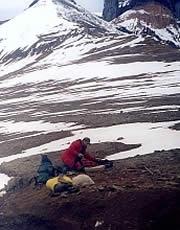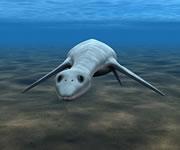 Digging in the cold for fossils.James E. Martin, South Dakota School of Mines and Technology
Digging in the cold for fossils.James E. Martin, South Dakota School of Mines and TechnologyJames Martin and the other eight members of his expedition to Antarctica are no strangers to hardship. They have camped out in freezing temperatures, endured week-long wind storms, and hiked across frozen terrain carrying heavy equipment.
The reward: a rare fossil of a juvenile reptile that patrolled the Southern Ocean 70 million years ago. It is the most complete fossil of its kind, and will be displayed at the South Dakota School of Mines and Technology's Museum of Geology in Rapid City on 13 December.
The fossil is what remains of a baby plesiosaur, less than 1.5 metres long. Plesiosaurs, despite the name, were aquatic reptiles and not dinosaurs — which are by definition terrestrial. They had long necks, a small head and four large flippers for swimming. A full-grown plesiosaur would measure about 10 metres from the top of its tiny head to the tip of its short tail.
This particular plesiosaur hails from an era when the Southern Ocean was warmer and Antarctica was covered with conifers and ferns, its climate more similar to today's southern South America than the frozen land we now know. The fossil was found in the ground (not the ice) of Vega Island, which lies off the Antarctic Peninsula.
It's hard to find fossils of juveniles, in part because when young animals met an untimely death it was usually at the jaws of predators, not leaving a skeleton behind. Because this fossil was surrounded by volcanic ash, researchers think that the young plesiosaur was caught in a cataclysmic volcanic eruption. Tony Fiorillo, a palaeontologist at the Dallas Museum of Nature and Science, Texas, also points out that infant fossils are hard to find because juvenile bones are not as well ossified as adult bones, and fall apart more easily over time.
"Baby plesiosaurs are super rare," says Benjamin Kear of the University of Adelaide in Australia who studies plesiosaurs of all ages. "To get a really good one is just fantastic."
With or without mum
 Artist's drawing of a pleisosaur.Trent Schindler, National Science Foundation
Artist's drawing of a pleisosaur.Trent Schindler, National Science FoundationKear says that studying the features of a juvenile plesiosaur can reveal details about the animal's life history, such as how independent young plesiosaurs were of their mothers. "If the teeth are well worn, the baby could have been feeding on its own," says Kear. Palaeontologists can also look at the skulls, he adds. Well-fused skull bones would suggest an ability to deal with struggling prey — a factor governing whether the juvenile is robust enough to survive on its own.
Unfortunately, neither approach is possible with the current fossil because the skull was never found. The team searched for it, but inclement weather forced them to give up their pursuit.
Lousy weather was a theme of the research expedition. The wind tossed gravel into the researchers' faces and made unearthing the fossil a great challenge. "We would uncover a few vertebrae and the wind would cover them back up," says Martin, who is at the South Dakota School of Mines and Technology's Museum of Geology. One week the wind speed reached 110 kilometres per hour. "And then it got cold," he adds.
Shame about the weather
After the team had excavated around the fossil, they needed to cover it in plaster, wrap it in canvas, and remove it from its resting place. That job took around 45 kilograms of plaster and a jackhammer — both of which the researchers carried from the base camp to the excavation site. They eventually pried the fossil free and airlifted it away by helicopter.
Fiorillo says these harsh weather tales sound all too familiar. He has been looking for fossils in northern Alaska since 1998, and describes the weather during his latest trip in August as "absolutely miserable". "We probably spent 40-50% of the time cooped up in our tents waiting for the weather to improve," he says. Nevertheless, the region has rewarded him with a rich diversity of fossils ranging from duckbill dinosaurs to pachycephalosaurs.
Fiorillo says the weather may not be quite as rough in Alaska as it is in the Antarctic, but that doesn't mean life is easy: "We also have to deal with grizzly bears."
Visit our reptilefossilfoundin_a.html">newsblog to read and post comments about this story.
